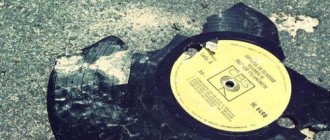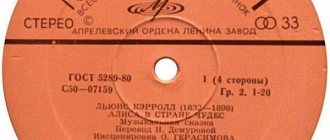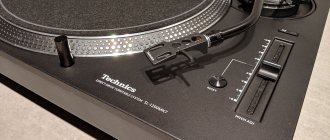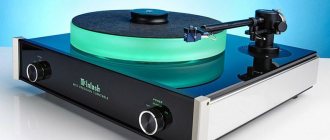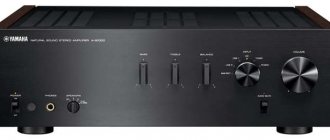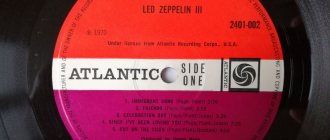In my editorial life, I haven’t tested any devices and accessories for audio equipment, but this is the first time I’ve gotten my hands on record cleaning products. Of course, in my practice of caring for records, I had the opportunity to try a lot of things, but writing a test is a different task. The task is not easy, because you need to evaluate the properties of detergent compositions in practice, and so that the result is reliable and the presentation is clear.
The very appearance of record care products from Analog Renaissance on the market made me very happy - after all, they are manufactured in Russia, and the prices are lower than their imported counterparts. However, you must agree that immediately upon the appearance of something on sale, trust in this product does not arise by default. On the contrary, I was even skeptic due to the fact that all the formulations in the catalog are alcohol-free, and for many years I have become accustomed to alcohol-containing liquids. But this is still a matter of habit, and not of the advantages of one type or another.
So, the Analog Renaissance company sent me three liquids for testing: Magic Groove Cleaner, Record Cleaning Liquid and Record Cleaning Liquid Concentrate and a mat in addition, which I will tell you about at the end. The first thing you want to know is the source “material”. The composition is described quite abstractly: a proprietary mixture of SYNTH2ON, which consists of various surfactants, a hydrotropic additive and purified water. There is little information for analysis from a chemical point of view; like most manufacturers, Analog Renaissance does not disclose the detailed recipe. However, I came across bottles that did not indicate anything at all, except whether or not the liquid contained alcohol.
First you should read the manufacturer's recommendations, there are several features there. The liquids, according to the description, are suitable for any washing method: manual or vacuum and ultrasonic cleaning machines. The compositions, and this is significant, can be used for both vinyl and shellac. Let me remind you that the latter requires very careful handling, in addition, no alcohol solutions should be used. The company writes that the liquids are well wetted, cope with various contaminants and do not leave traces - all this needs to be tested in practice, because not a single manufacturer in the world has ever written that its compositions wash so-so. Before moving on to practical tests, it’s worth remembering (and not for the first time) a few important points about washing vinyl.
Four reasons to wash a record
First and most importantly, vinyl needs to be washed. Especially if you want to get good sound and also preserve the needle and record. A dirty record always sounds worse than a clean one. Dirt in the grooves contributes its “component” to the sound, and the effect can be very noticeable - it all depends on the degree of dirt and the type of needle. It is clear that if it doesn’t matter to you how many times something clicks, and you haven’t configured the path and you listen to music according to the “it will do” principle, keeping the discs clean will be a minor matter. But owners of high-quality systems and music libraries with rare and expensive records certainly cannot do without washing.
I will add that records are often sold on the secondary market that, upon first listening, hardly qualify for VG condition, but after a good wash it turns out that the disc deserves a completely honest NM. That is, the problem was not in the “filing” of the record, but in its contamination. Finally, washing largely eliminates the problem of static, and it is relevant for both old and new records. You can also hear static, and sometimes you can hear it very well.
An ordinary record, about 40 years old, never washed, cleaned with some kind of average brush and stored in an inner paper sleeve that had begun to crumble. If you evaluate the sound - the crackling and clicks are approximately VG+ or a slightly better rating
The second point is the effect of dirt on wear. Paper dust from an envelope, accumulated in the grooves over several decades, is not the worst thing, although it will affect the sound. But house dust contains not only paper - it also contains sand. Even if the player is in a perfectly clean room, to a small extent, the problem will remain. Especially if the record came from a secondary market with all the dirt present. Put a simple picture in your head: on one side there is a groove, the material is quite delicate, you can damage it with a fingernail, and on the other there is a diamond needle (as far as this hard material is known to everyone). If you try to estimate how long it takes for a needle, under a small load, to travel along a groove at a not very terrible speed to wear out, then what will happen? It will be assumed that manufacturers give wear times based on ordinary, moderately dirty records, but the time is significantly reduced when the needle comes into contact with dirt, especially “mineral” dirt. And this is indirectly confirmed by the observations of those owners who take good care of the plates and tract - indeed, their service life of the head needle turns out to be more or less longer than the passport one. Of course, with all this, the wear and tear of the record itself is no less significant, especially when it comes to rare and expensive editions.
The third point is that new records should also be washed. After pressing, technical impurities may remain, which can be heard as “sand.” It will disappear after the first wash.
And the fourth point should be your understanding that caring for vinyl is no less important than fine-tuning the tonearm or selecting the head and other components of the tract. Moreover, everything is important: washing, handling, cleaning, choosing good envelopes, proper storage. If you decide to go into vinyl, remember: the format is capricious and not without its drawbacks. And if you really want to get the maximum sound, you will have to pay attention to all sorts of seemingly little things.
Why wash records?
The record itself is nothing more than a vinyl disc, on each side of which a groove is applied along an involute, with a certain depth, with a certain trajectory and with a microrelief inside the groove. If you noticed, then everything again is an exclusively mechanical system. Since the cleanliness of the surface in the grooves will determine the trajectory of the needle movement, and accordingly the signal issued by the head, it goes without saying that it is necessary to fight for the initial parameters of the grooves provided by the manufacturer. But life is not an ideal series, but real reality, where there is a place for dust, greasy stains from your hands, after a delicious pie, and simply misunderstandings that can significantly spoil your records, simply by depositing on it, or rather on its grooves, any foreign inclusions . We can only repeat that no matter how hard you try to protect records from this, dust will still accumulate on them, even from the paper envelope in which they are simply stored in your record library on the shelf. So from time to time, the records still need to be washed.
Alcohol or not alcohol
As part of this test, I also want to raise the issue of alcohol-containing and non-alcohol liquids. Although I have always been more inclined to use the former, this is not at all necessary. Not all stains found on records necessarily require alcohol as a solvent. In addition, liquids with a significant concentration of alcohol evaporate quickly - when the disc needs to be “soaked” a little during the washing process, the solution will have to be applied twice or three times.
Finally, washing records with an alcohol-containing liquid, especially isopropyl alcohol, is still a pleasure. The smell in the room is strong, and inhaling these vapors is, of course, harmful. Personally, I have a rule not to put dirty records under the needle, even if I really want to. But it is also irrational to wash them individually. Most often, 10-20 records are collected and washed at a time. And even though my family understands perfectly well what’s what and is sympathetic to my hobby, I prefer to organize a “bath day” when no one is at home, having previously expelled the pets from the room. From other vinyl producers, I have heard stories about quarrels with wives and mothers-in-law, even to the point of sending the entire washing supply down the drain... I don’t even want to remember the problems with the production, sale and shipment of alcohol-containing liquids. In general, alcohol solutions are a significant inconvenience.
The same plate after washing. Yes, it would be best to provide a photo with a much higher magnification, but technically this turned out to be impossible. But this was compensated by the ear rating - the record turned out to be an honest EX+ (with a big plus) or even NM
I think from all of the above it became clear to you why alcohol-free liquids are in demand on the market. Well-cleaning alcohol-free liquids are doubly in demand. After all, the problem is that among alcohol-free ones you can often find something awkward, more likely to stain than to clean.
I note that if the plate does not have particularly complex stains, it can be washed normally with any type of liquid. Equally good results can be obtained both with a washing machine and with hand washing. The only question is the complexity, tediousness and duration of the process, as well as strict adherence to all technologies. At a time when only hand washing was available to me, I spent about an hour and a half to two hours washing 15 records, plus a fully occupied bathtub, several basins, and then another couple of hours drying. The machine washes the same 15 records much faster, without much effort, and the result is guaranteed.
Secrets of vinyl storage
Can PVA glue clean a record from simple stains?
Seasoned vinyl lovers recommend that after processing and cleaning the record, replace its inner sleeve with a new, clean and fresh one. And after that, put everything in the outer envelope. But there are some pitfalls here.
For better storage of vinyl, you should first clean the inside and its outer cover (it is usually made of cardboard). To do this, you can use a metal ruler wrapped in several layers of gauze and a regular vacuum cleaner with a flat, short nozzle.
Changing the inner envelope is a serious matter. As a replacement for your original envelope, choose durable, high-quality, dense envelopes that can both protect vinyl from mechanical damage and insulate it from static electricity.
Standard paper envelopes are actually the worst option (especially those with an apple hole). Film sleeves are also not suitable because they have a habit of bunching up when the record is put into the outer sleeve.
The best in their category are considered to be products that combine both materials: film and paper. They are not the cheapest, but they are the most reliable. Valuable collections, as a rule, are stored in such envelopes.
Before you act according to the instructions and rules, secure yourself with an expert opinion!
Initial data
Enough theory, it’s time to move on to practice and testing Analog Renaissance products. The first bottle is Analog Renaissance Magic Groove Cleaner spray, designed for “quick routine care” of records. In my understanding, it is suitable for slightly dirty or already washed discs. The spray comes with a good quality microfiber cloth. The spray is supplied in 250 ml containers. Using such tools is more a matter of habit, but if you learn to use them correctly and carefully, you will get results.
The second bottle is Analog Renaissance Record Cleaning Liquid. This is a ready-made washing liquid for vinyl and shellac for all types of washing. Volume - 500 ml. This is what will become the first and main one in the testing process.
Analog Renaissance Record Cleaning Liquid
The third bottle is Record Cleaning Liquid Concentrate. Volume - 100 ml, there is a transparent dosage scale. This is a concentrate for preparing a cleaning solution. The bottle is diluted with distilled water to obtain 5 liters of the finished composition. I note that it is desirable to have distilled water, devoid of any dissolved salts. Otherwise, after drying, they will remain on the surface in the form of sediment or crystals. No washing machine removes all the moisture; small traces always remain. Moreover, salted brushes on vacuum machines will not do any good.
All solutions are transparent, slightly soapy, the concentrate is slightly less transparent and thicker. The solutions have virtually no odor, and there are no fragrances in the composition.
Judging by the description, all three products are based on the same concentrate (SYNTH2ON mixture), only diluted in different proportions. If so, then you need to start with ordinary, ordinary, ready-made washing liquid.
Analog Renaissance Record Cleaning Liquid Concentrate
For practical tests, I prepared about a dozen records in very different conditions: several interesting, but very dusty editions on Melodiya; old, clicking, but outwardly “alive” Decca and Verve; a couple of Japanese records, seemingly intact, but washed by the previous owner with something slightly sticky (possibly wet playing compound - hard to say, there is not the slightest trace on the sleeves, so I believe this is the result of improper care, and not spilled soda ); and a couple of new records, perfectly clean in appearance, but with a fair amount of clicking, albeit not loud.
The washing machine used in the test was Okki Nokki RCM ll - one of the most common machines - simple, convenient and reliable.
Devices for washing records (sinks, etc.)
Throughout the existence of vinyl records, and even today, there are ready-made solutions that are designed to facilitate your procedures for laundering records. So the simplest auxiliary washing of records is a set of two glasses in the form of a circle with seals and handles, which are held together by means of a pin.
It’s difficult to call such a device a sink, but some call it. In fact, its main function is to protect the record label from moisture and to conveniently hold the record during washing. Of course, there are also professional sinks designed for washing records, in the form of a container over which the record is hung and rotated around an axis. In this case, the plate is washed with washing liquid and subsequently dried.
The most expensive car wash options are designed to do everything for you. This way the record is installed on the sink as if on a turntable. Then it rotates, and at this time washing liquid is applied to it from a sprayer. Then, after some time, this liquid is pumped out from the surface of the plates using a suction device. So we realized that records can be washed in different ways, but from what was described above we wanted to bring you one thing. Firstly, auxiliary devices (record washers) are also not perfect. So, for example, there is no need to protect the sticker of the plate from moisture; do not be afraid to wet it with plain water for 3-4 minutes while washing. On a good record, nothing will ever be done to the sticker during this time (based on my own experience), and if so, then there was nothing to regret. (the record is so-so...) Secondly, real professional washers are very expensive, their cost can be close to that of a record player, but they will take up space, consume electricity, etc.
In general, for the average person, the method described below is quite suitable; it will yield tangible results, while requiring a minimum of skill and money from you.
Experiments
I didn’t immediately pour the solution, but first did a couple of simple experiments - anyone can repeat them at home without negative consequences. The first tablet I came across was a tablet with fingerprints on the screen - how could it be otherwise? I tried wiping the screen with a regular napkin moistened with Analog Renaissance Record Cleaning Liquid. Removed all traces unexpectedly quickly and easily. This action usually requires more effort.
Marks left on glass after liquids dry. On the left is Analog Renaissance Record Cleaning Liquid, in the middle is distilled water (apparently, not the best quality, so you shouldn’t always trust what is sold in auto stores), on the right is regular tap water
I conducted the next test, again, on the screen of an experimental tablet. I wetted three napkins: one with tap water, the second with distilled water, and the third with washing liquid. I put a few blots on the glass and left it to dry. Ordinary water left noticeable marks that cannot be erased with one swipe of a napkin. I had different distilled water, both laboratory and from a car dealership. The latter turned out to be not of very high quality, and the marks were noticeable. It is also useful to take note of this possible difference. The record cleaning solution did not leave any noticeable marks. This is a good result, which means the solution cleans without leaving a trace.
For staunch supporters of alcohol liquids with added detergent components, I conducted another test. I mixed 2 ml of washing liquid and 2 ml of isopropyl alcohol, and did the same with the concentrate. In both cases, there were no flakes or sediment even after three days of “infusion.” Looking ahead, I’ll say that adding liquids from Analog Renaissance is certainly better than dishwashing detergent or baby shampoo (such advice can be found on forums), they are clearly less washed off and leave a persistent chemical smell.
Washing
And so I started washing the records indicated above. Most of the discs were washed the first time and using the most usual method: applied it to the record with a brush, waited 10 seconds, turned on the pump, turned the record two or three times in each direction - and you were done. A couple of the records had to be washed twice, letting the solution sit for a few minutes before removing it with a pump.
The good result was confirmed by listening and examination under high magnification (examined before and after, noted control sectors regarding the position of the apple). Only one attempt with a new-made disc was unsuccessful, but after washing it with other means, including alcohol, I came to the conclusion that the problem was a manufacturing defect in the disc itself, and not its contamination.
In the process, I examined the condition of the tracks under high magnification - the result was good. One small observation also speaks very well about the result: if a record, which we assume has been well washed, is put on the player and listened to, then in the case when a decent amount of dirt remains, this same dirt can be found on the needle after listening.
The washing process itself turned out to be mundane—I didn’t notice anything phenomenal. The detergent composition works, and nothing more is required from it. I will only note that a drop of solution accidentally falling on the apple of the record will damage the record with less probability than if we took an alcohol liquid.
I did not dilute Analog Renaissance Record Cleaning Liquid Concentrate in full with 4.9 liters of distilled water - I didn’t need that much. I didn’t bother checking the volume on the scale, but simply measured out the required amount of concentrate with a syringe and diluted it into 0.5 liters of water. Outwardly, I did not notice the difference between the finished liquid and the concentrate.
Transparent scale for dosing Analog Renaissance Record Cleaning Liquid Concentrate
By the way, I would not literally follow the manufacturer's recommendations for this concentrate. The company writes that the resulting 5 liters will be enough to wash 200 records. In my practice, if you do not need to wash a large proportion of contaminated discs twice, and also use the solution carefully (but do not skimp), the volume of the bottle will be enough for a larger number of discs.
And one more detail in the description that raised questions in me - the advice to use undiluted concentrate in special cases of severe contamination. Let's start with the fact that undiluted concentrate is difficult to remove from the plate and the brushes on the machine become clearly soapy. Perhaps it makes sense to apply pure concentrate to particularly problematic areas, and then remove it with a napkin, which has been previously dipped in distilled water. And after that, wash the record in the usual way. I didn't have any discs stained with ketchup twenty years ago to try this action. But even if they were found, I would prefer to first soak the dirt with a soap-alcohol solution, remove all traces, and then wash the record as usual. Because neither a concentrate nor a vacuum machine can cope with such contaminants.
Analog Renaissance Magic Groove Cleaner spray, to be honest, doesn’t really fit into my vinyl care ideology, but it’s still a matter of habit. Although I would never spray anything on the turntable. However, if we abstract from the application method, it may not be harmful to sometimes walk over the plate with a damp microfiber cloth, collect dust and remove static. But this method is definitely only suitable for maintaining cleanliness - no dirt can be removed from the depths of the groove this way.
The main enemies of vinyl discs
About 40-50 years ago, when vinyl was in its heyday and such records were in literally every home, most people were well aware of their shortcomings. As now, the main enemies of disks then were:
- dirt;
- dust;
- fat (including from fingers);
- scratches and chips.
But if in the latter case the disc was most often sent to the trash heap, since listening to it became impossible, then almost every Soviet person knew how to clean vinyl records from dirt and dust. There are several proven ways to get rid of greasy stains and deep dirt. But proper care of vinyl records in the vast majority of cases begins with washing them.
Mat
Analog Renaissance Stylus Cleaning Liquid was not included in the test kit, so I have nothing to say about it. But the company included the only accessory it produces - Analog Renaissance Cleaning Work Mat. And he interested me no less than liquids.
The square silicone mat has circular protrusions designed to hold the plates in place (without snapping, of course). It is designed for 12-inch wheels; there are no bezels for 10 and 7 inches - this is technically impossible. In addition to the record, you can place a CD or DVD disc in the center of the mat. The main purpose is to wipe the plate or disc on a clean (the mat is easy to clean) and non-traumatic surface. Clean with Analog Renaissance Magic Groove Cleaner spray or a brush. I have previously encountered similar swear words, but only on the principle of purpose. For example, the mat from Analogue Studio is much less convenient to use in practice.
If we talk about using sprays, then the mat is really needed - you can clean the record in any convenient place, and not on the player’s disk, and then rinse the mat itself. In the case of brushes, it also makes sense. On many modern players, the record on the disk begins to slip even with a brush, and not everyone has clamps. In general, adjusted for the lack of rotation, brushing can be effective and convenient.
In addition to everything described above, I found several more uses for this mat. You need to examine the defect of the record under a magnifying glass, see the matrix number, read and rewrite something from an apple, or compare some features of the record with pictures from the Internet - all this is more convenient to do on a clean and safe surface. The mat is ideal for these purposes.
Finally, photographing records on this mat is very convenient. It can be placed on an inclined surface - and it itself will not slip anywhere, and the record will not move out. The only minor, but still drawback, is that the mat would have come with a hard envelope for storage. Standard film packaging is more suitable for transportation and sale, but not for home storage with regular use, although it is important to keep this instrument clean.
Analog Renaissance has its own online store lpclear.com, where you can view prices and other information from the manufacturer.
